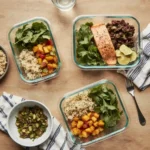Make meal prep stress-free and healing with this anti-inflammatory checklist
Meal prepping can feel like one more thing on your plate—until you realize how much easier your week flows when your meals are already ready. If you’re following an anti-inflammatory diet, planning ahead is more than just a time-saver—it’s the key to consistency. The right foods can support joint health, reduce fatigue, and even improve digestion. But without a good plan, it’s easy to fall back on old habits.
In this guide, I’ll walk you through a simple and realistic meal prep checklist for an anti-inflammatory diet. You’ll discover how to shop smart, cook efficiently, and store everything safely—so healthy eating becomes second nature.
Let’s dive into the first step: getting your kitchen stocked with the right ingredients.
Grocery Planning for an Anti-Inflammatory Diet
Stock Up on Weekly Anti-Inflammatory Staples
When it comes to managing inflammation through food, having the right ingredients in your pantry and fridge is everything. A well-stocked kitchen helps you avoid last-minute takeout or less nourishing options. Every week, set aside time to refresh your supply of go-to anti-inflammatory ingredients.
Here are some essentials to prioritize:
- Leafy greens: spinach, kale, arugula
- Berries: blueberries, raspberries, blackberries
- Healthy fats: extra virgin olive oil, avocado, walnuts
- Fatty fish: wild-caught salmon, sardines
- Herbs and spices: turmeric, ginger, garlic
- Whole grains: quinoa, oats, brown rice
- Plant-based proteins: lentils, chickpeas, tofu
- Low-sugar fermented foods: kimchi, sauerkraut, unsweetened yogurt

Anti-Inflammatory Meal Prep Checklist
Equipment
- Sheet pan
- – Large pot
- Storage containers (BPA-free)
- Marker or labels
- Cutting board & sharp knife
- Blender (for smoothies)
Ingredients
- Leafy greens (spinach, kale, arugula)
- Berries (blueberries, raspberries, blackberries)
- Extra virgin olive oil
- Avocados
- Walnuts
- Wild-caught salmon
- Sardines
- Turmeric, ginger, garlic
- Quinoa, oats, brown rice
- Lentils, chickpeas, tofu
- Kimchi, sauerkraut, unsweetened yogurt
Instructions
- Check your pantry and fridge for anti-inflammatory staples like spices, grains, healthy oils, and fermented foods. Take note of what needs restocking.
- Create a categorized grocery list by produce, proteins, pantry, and freezer. Choose seasonal, fresh items when possible.
- Select 2–3 lean or plant-based proteins such as salmon, lentils, or organic chicken. Cook in bulk using sheet pans or stovetop methods.
- Prepare 1–2 whole grains like quinoa or brown rice. Cook large batches and store them in airtight containers once cooled.
- Roast 3–4 colorful veggies such as sweet potatoes, broccoli, and bell peppers with olive oil and herbs at 400°F until tender.
- Portion prepared food into BPA-free, stackable containers. Label each with the contents and date.
- Freeze extra portions you won’t eat within 3–4 days. Organize containers so older meals are eaten first.
- Clean your prep space and get it ready for next week. Keep your checklist in a visible spot to repeat the cycle easily.
Notes
Choosing fresh, seasonal produce adds flavor while keeping your meals interesting week after week. If you find yourself short on time, frozen fruits and veggies are a great backup—they’re often picked at peak ripeness and retain their nutrients well.
To stay organized, keep a running grocery list on your phone or a magnet notepad on your fridge. Categorize items by produce, proteins, pantry, and freezer so your shopping trips are quick and efficient.
Stick to a Simple Formula
A little structure goes a long way. Pick one or two proteins, a couple of grains, and three or four veggies for the week. This strategy makes batch cooking feel doable and ensures you have enough variety without getting overwhelmed. Having a plan also reduces food waste and keeps your meals balanced.
Weekly Batch Cooking for an Anti-Inflammatory Diet
Prep Protein Powerhouses in Advance
One of the biggest hurdles in healthy eating is standing at the stove on a busy weeknight with no plan. That’s where batch cooking comes in. Preparing a few key proteins ahead of time makes it easier to assemble nourishing meals that support your anti-inflammatory goals.
Focus on lean, clean sources of protein like:
- Grilled or baked salmon: Rich in omega-3 fatty acids that help lower inflammation markers
- Boiled or roasted lentils: Packed with fiber and plant-based protein
- Organic chicken thighs or breasts: Season simply with turmeric, garlic, and lemon
These can be cooked all at once on a sheet pan or stovetop, then stored for use in bowls, wraps, or grain salads. Consider doubling your recipes and freezing half—so next week’s prep is already halfway done.
Cook once, eat multiple times. That’s the mindset that keeps anti-inflammatory eating realistic.
Whole Grains & Roasted Veggies Made Simple
Next, turn your attention to fiber-rich grains and colorful vegetables. These are the base of every meal on this checklist. Their natural antioxidants and nutrients work to calm chronic inflammation from the inside out.
Choose two grains to prepare:
- Quinoa cooks quickly and is a complete protein
- Brown rice keeps well and pairs with just about anything
Boil a large batch and let it cool before storing in airtight containers.
For veggies, aim for variety and color. Roast trays of:
- Sweet potatoes
- Carrots
- Zucchini
- Broccoli
- Bell peppers
Toss them with olive oil, garlic, and herbs like rosemary or thyme before baking. Roast at 400°F until tender and slightly caramelized. Let them cool fully before transferring to storage containers.
Once these are prepped, you’ve got endless mix-and-match meals ready to go. A warm quinoa bowl with salmon and roasted veggies? Done. A quick rice wrap with lentils and spinach? Easy. That’s the beauty of batch prep.
Smart Storage & Containers That Work
Choose the Right Containers for Longevity
Once your meals are prepped, where and how you store them matters just as much as what’s in them. Using the wrong containers can lead to soggy vegetables, dry proteins, or worse—unsafe food.
Here’s what to look for:
- BPA-free materials: Choose glass or high-quality plastic that’s labeled BPA-free to avoid chemicals that may contribute to inflammation.
- Freezer-safe and microwave-safe: Containers that go from freezer to fridge to microwave make your meal prep process smoother.
- Stackable designs: Maximize fridge space and reduce clutter with containers that fit together neatly.
- Portion-sized options: Having smaller containers on hand makes grab-and-go meals more practical, especially for lunches and snacks.
If you’re prepping soups or stews, consider wide-mouth mason jars or freezer-safe silicone bags that lie flat and defrost quickly.
You don’t need a hundred containers—just a few versatile sets you can count on week after week.
Label & Date Everything to Stay on Track
You’ve put in the time to prep your meals—now protect your investment. Labeling your containers helps avoid mystery meals and ensures nothing goes bad before it’s eaten.
A few simple habits make a big difference:
- Use masking tape and a permanent marker to write the prep date and contents.
- Store meals you plan to eat first at the front of the fridge.
- Freeze anything you won’t eat within 3–4 days.
If you’re feeling fancy, printable labels or a chalkboard pen can add a fun touch—but pen and tape work just as well.
Storing food correctly also means safer eating. Cooked grains and proteins typically last 3–4 days in the fridge or up to 3 months in the freezer. Be sure to cool foods fully before sealing and storing to avoid moisture buildup and spoilage.
Printable Prep Checklist & Smart Tips to Stick With It
Your Anti-Inflammatory Meal Prep Checklist
Sometimes the hardest part of meal prep is knowing where to start. That’s why having a simple, visual checklist helps. It keeps you focused, saves time, and makes the entire process more enjoyable. Whether you tape it to your fridge or keep it in a meal planner, this weekly guide keeps your routine tight and manageable.
Here’s your quick-start checklist:
- ☐ Check pantry for weekly staples (spices, grains, oils)
- ☐ Write grocery list by category (produce, protein, pantry, freezer)
- ☐ Buy leafy greens, berries, and colorful veggies
- ☐ Choose 2–3 proteins to batch cook (e.g., salmon, lentils)
- ☐ Cook 1–2 grains (e.g., quinoa, brown rice)
- ☐ Roast 3–4 veggies for variety
- ☐ Cool and portion meals into BPA-free containers
- ☐ Label containers with date and contents
- ☐ Freeze extra portions for later use
- ☐ Clean up and prep space for next week
You can print this out or copy it into your favorite meal planner app. Once this checklist becomes part of your weekend, you’ll notice how much smoother your weekdays feel—and how much easier it is to stay committed to your anti-inflammatory goals.
Bonus Tips to Stay Consistent Without Getting Bored
Sticking with any lifestyle change takes more than just good intentions. These small tricks help keep things interesting and sustainable, especially when life gets busy.
Pre-portion smoothies for busy mornings. Blend ingredients like spinach, berries, flaxseed, and nut butter into freezer bags or jars. Come morning, just add liquid and blend.
Theme your meals. Assign days like “Mediterranean Monday” or “Soup & Salad Wednesday” to cut down on decision fatigue. It adds variety without overthinking.
Don’t aim for perfection. Some weeks will be better than others. If all you can manage is pre-washing your greens and cooking one protein, that still counts as a win.
Keep backup meals in the freezer. Having a few full meals tucked away makes it easier to stay on track during hectic weeks.
Meal prep is about giving your future self a break—not creating more pressure. Start small, stay flexible, and celebrate each step toward consistency.
FAQs: Anti-Inflammatory Meal Prep Made Simple
1. What are the best anti-inflammatory foods to prep?
Great choices include leafy greens, berries, wild salmon, turmeric-spiced lentils, and whole grains like quinoa and oats. Roasted vegetables with olive oil are also excellent.
2. How long do prepped meals last in the fridge?
Prepped meals usually keep fresh for three to four days. Be sure to cool food completely before sealing and always label with the prep date.
3. Can I freeze anti-inflammatory meals?
Yes, absolutely. Grains, proteins, and soups freeze well. Use freezer-safe containers, remove excess air, and label clearly.
4. How do I avoid getting bored with my meals?
Mix things up by rotating herbs, using themed meal nights, and trying seasonal ingredients. Batch prep basic items, then dress them up with different sauces and toppings each day.
Conclusion
Putting together a meal prep plan for anti-inflammatory eating can feel totally manageable. When you stock the right foods, cook efficiently, store smartly, and keep a simple checklist, the process becomes second nature. These small weekly steps add up to big long-term changes—for your energy, digestion, and overall well-being.






1 thought on “Meal Prep Checklist for Anti-Inflammatory Diet”